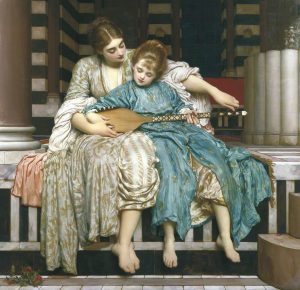 Appel à communication : « Thinking in the Box: The Benefits of Artistic Tradition in the Nineteenth Century » (14-15 mai 2020, La Haye)
Appel à communication : « Thinking in the Box: The Benefits of Artistic Tradition in the Nineteenth Century » (14-15 mai 2020, La Haye)
Organised by the European Society for Nineteenth-Century Art (ESNA)
14-15 May 2020: The Hague, RKD – Netherlands Institute for Art History
Keynote: Liz Prettejohn (University of York)
Submission deadline: 20 December 2019
Poetry and progress are like two ambitious men who hate one another with an instinctive hatred, and when they meet upon the same road, one of them has to give place. Charles Baudelaire, Salon of 1859
Tradition is art history’s eternal Other: it is that which must be overcome, resisted, thrown off or, if a compromise must be made, creatively appropriated. The history of the art of the nineteenth century, that “great” age of innovation, progress and revolution, is more than any other rooted in anti-traditionalist sentiment, steeped in a rhetoric that privileges innovation and bound to narrative structures geared against artistic tradition. Modernist and other teleological histories of nineteenth-century art have always emphasised change and novelty. But even revisionist accounts of the art of the nineteenth century leave scarcely any room to consider tradition in its own right. These have generally either sung the aesthetic praises of traditional art without much further reflection, or have discussed academic art as innovative in another way, either within a traditional framework or in the sense that the art under consideration points forward to developments other than those associated with formal modernism.
This rejection of artistic tradition may be due to its use in fascist and totalitarian ideologies, but is also the result of a structuralist approach within the discipline of art history that continuously opposes new and old (with “old” always being the marked term). Ironically, this structural divide is in part a product of the nineteenth century itself: it stems from the rising historical (and art-historical) consciousness of the time and its clash with a strong belief in change and progress. This all-too-simple opposition between what was and what will be still shapes our understanding of the artistic act. True art, it seems, must be the creation of something out of nothing—a belief stemming from the early-nineteenth-century romantic philosophy of art and, later, a major tenet of modernist criticism. The result has been that art historians are rarely able to think around the categories of tradition and innovation and nearly always address tradition solely as a problem. Seldom is the richness of artistic tradition itself explored.
The question remains whether this rejection of artistic tradition does justice to what art really is, or, better, what it was understood to be in the nineteenth century. For Charles Baudelaire, the answer would have been in the negative. In his Salon of 1859, he observed that “poetry and progress are like two ambitious men who hate one another with an instinctive hatred”. This conference invites papers that consider artistic tradition not as the nemesis of creation but in its own right. It aims to examine the potential artistic, commercial and even political benefits of thinking in the box—of continuing artistic tradition(s), working within them or reverting to them during the (long) nineteenth century. What could tradition yield for artists and the way they understood their art that innovation could not? What could it do for audiences and what they might have sought in artworks? What could it achieve for patrons, with their various social, political and aesthetic agendas? We invite papers that deal with the “problem” of tradition in nineteenth-century art, but which do not address the phenomenon itself as a problem. We especially welcome proposals that explore or develop new theoretical paradigms to study the relationship between nineteenth-century art and artistic tradition.
Subject that papers may address include:
- Patterns of artistic imitation and emulation;
- Historical and academic pastiche and its collectors;
- “Retrograde” and “reactionary” art;
- Antoine Compagnon’s “anti-moderne” in the visual arts;
- William Marx’s “arrière-garde” in the visual arts;
- Reconsidering or rethinking Harold Bloom’s concepts of “anxiety of influence” and “belatedness”;
- Political uses of artistic tradition or traditional art (local, regional and national);
- The geography of tradition: metropolitan and provincial attitudes towards tradition;
- Class, gender and “race” in the face of artistic tradition;
- Markets for traditional art;
- Academic theory and art education (e.g. drawing manuals, plaster copies, museums and academic collections of copies);
- Non-avant-garde art criticism and art discourse;
- Processes of art historical canonisation (e.g. in scholarship, popular publications, pantheons of art, collecting practices, etc) and the dialogue between contemporary art and the Old Masters.
Please send proposals (max. 300 words) for a 20-minute paper in English, French or German and a brief CV to esnaonline@hotmail.com by 20 December 2019 at the latest. Selected speakers will be contacted in January 2020.
Organising committee: Jan Dirk Baetens (Radboud University Nijmegen), Mayken Jonkman (RKD – Netherlands Institute for Art History, The Hague) and Myrthe Krom (Museum Gouda).
Scientific committee: Maite van Dijk (Van Gogh Museum, Amsterdam), Rachel Esner (University of Amsterdam), Liz Prettejohn (University of York), Jenny Reynaerts (Rijksmuseum, Amsterdam), Marjan Sterckx (Ghent University), Chris Stolwijk (RKD – Netherlands Institute for Art History, The Hague, and University of Utrecht).
www.esnaonline.wordpress.com

Leave a Reply
You must be logged in to post a comment.